BenQ XL2720T Gaming Monitor Reviewed
by Chris Heinonen on June 17, 2013 4:35 PM ESTOur second calibration target is designed for print work, with a light output of 80 nits instead of 200 nits, and the sRGB gamma curve instead of the 2.2 Power Curve.
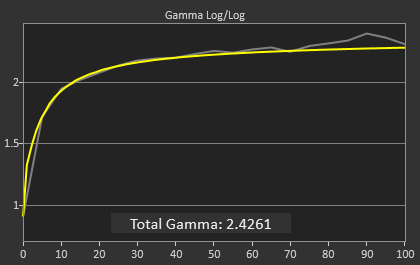
The grayscale continues to be excellent, even better than with the first calibration but you wouldn’t be able to tell even if they were side-by-side. There is a bit of a spike in the gamma that keeps it from being perfect, but even that spike doesn’t cause the dE2000 to rise at all. The biggest problem is that the contrast ratio has fallen down to 488:1 from the prior 820:1 level. Possibly the LED backlight doesn’t dim enough for the darkest settings, or the maximum light output was still too high and the LUTs had to be heavily lowered, either of which will cause a loss of contrast ratio. That issue aside, the grayscale calibration is very good.
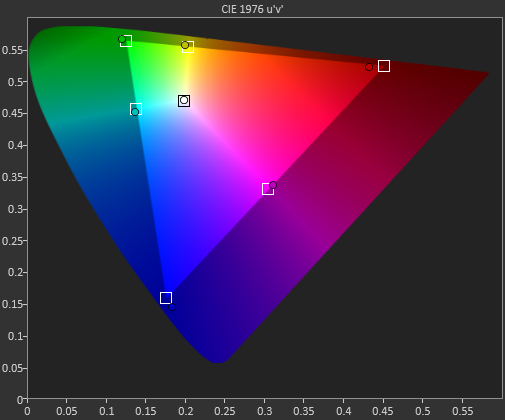
Color gamut is almost identical to at 200 nits. Too low of luminance in green, too little saturation in red, otherwise pretty good.

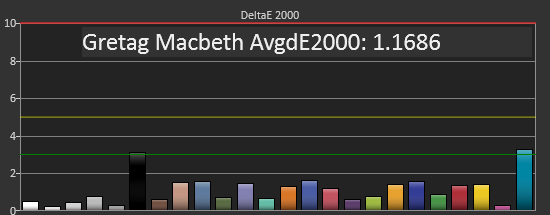

The colorchecker data here really surprises me. The yellow-orange shades that have been causing us such issues are no longer a problem. Now that shade of blue that lies on the edge of the sRGB target is causing the issue. I imagine the blue issue is related to the lack of green luminance, which affects cyan shades because of that. At lower light output levels, the error level in blue readings can be higher, since their light output is low to begin with, and if the green component is low in luminance, that can cause a much larger drop in the light output, leading to a larger error. Looking at the DeltaL chart for this measurement shows that it is quite low in luminance, which is almost certainly causing most of that color error. As to why orange-yellow shades improved so much, I have absolutely no idea.
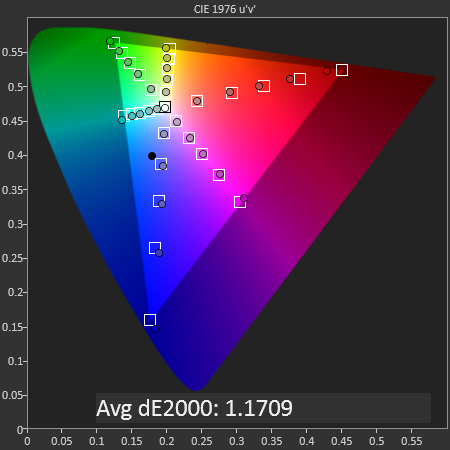
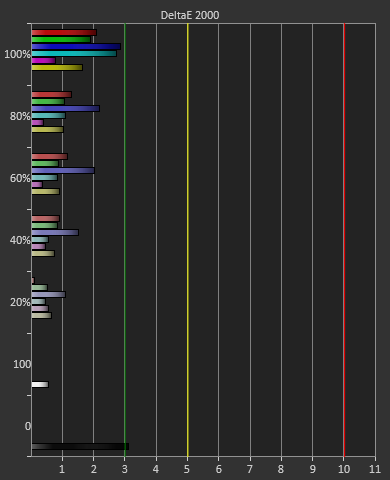
Saturations are much like they are on the last calibration, with 100% having the largest error and the numbers falling from there. 100% numbers are harder to correct since those saturations might be lacking luminance or saturation, which can’t be corrected. If a saturation below 100% is lacking saturation, we can increase that to compensate, which will reduce error, but that can’t be done with the 100% values.
Overall the sRGB target calibration is also very good, with a couple issues that came up. The biggest concern to me is that the contrast ratio drops so much, which will lead to a flatter, more washed-out image in appearance, but I didn’t see a way to correct it in several more calibration attempts.


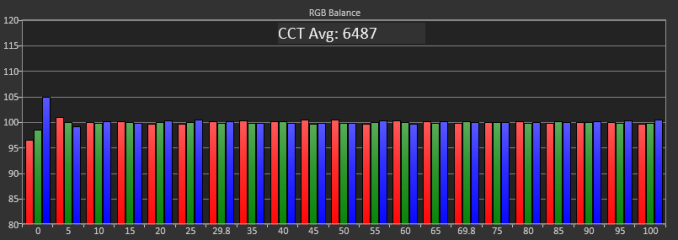
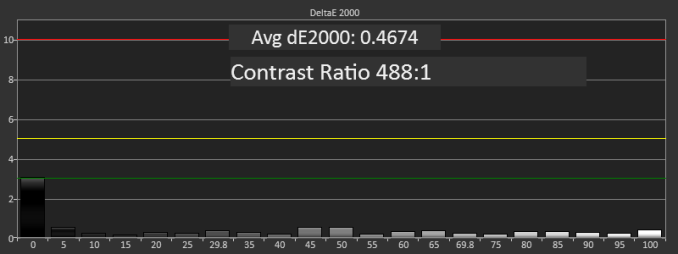










79 Comments
View All Comments
Pastuch - Tuesday, June 18, 2013 - link
"The input lag is because the Leo Bodnar input lag tester is limited to 60Hz and HDMI. So it's not an accurate measurement of input lag."If this is true you need to change your testing method completely. 120hz displays should be tested for input lag at 120hz with a dual link DVI cable preferably with Lightboost enabled in gaming mode!
mdrejhon - Tuesday, June 18, 2013 - link
Input lag should be measured with and without LightBoost.There's a very interesting phenomenon with LightBoost with input lag testers including my Arduino Input Lag Tester (google "Arduino Input Lag Tester"; contact me if you want to be on the beta test list). My input lag tester, that I am designing at Blur Busters, supports all refresh rates on all inputs.
LightBoost is an all-at-once strobe backlight (flashes only on fully-refreshed frames) so the input lag is identical for the top and bottom edges of the screen. The top of the screen has more lag relative to non-LightBoost, but the bottom edge of LightBoost has almost identical lag to non-LightBoost.
I am very impressed that so many people here know about LightBoost & are gently nudging the reviewer for forgetting to test this very important monitor-selling feature (as evidenced by mentions of LightBoost by end users in Amazon and NewEgg reviews)
mdrejhon - Tuesday, June 18, 2013 - link
UPDATE:-- The LightBoost HOWTO is now updated -- http://www.blurbusters.com/zero-motion-blur/lightb...
Easier method. No .reg and .inf files needed anymore! (Completely removed from HOWTO)
-- ToastyX informs that the new utility is coming by July that makes enabling LightBoost as easy as pressing a hotkey!
Good news indeed!
mdrejhon - Wednesday, June 19, 2013 - link
P.S. For those wanting motion clarity matching the Sony FW900 CRT, reduce the LightBoost percentage setting via the monitor on-screen menus (On the XL2720T, you have to find the Brightness/Contrast setting then, scroll down to below the bottom of the menu).This takes a slight hit to light output, but eliminates even more motion blur because the strobe flash lengths are shorter (motion becomes even sharper). The best motion clarity occurs at the LightBoost=10% setting -- the backlight is strobing for a mere 1.4 milliseconds; resulting in 92% clearer motion than a 60Hz monitor. This works great in dark rooms at night, when the higher brightness modes are too bright anyway.
blackoctagon - Wednesday, June 19, 2013 - link
"The only reason people are still buying 120hz displays is for Lightboost capable 2d gaming."-As exciting as the (NVIDIA-ONLY) LightBoost hack is, it is not the "only" reason people buy 120Hz monitors. Plenty of people buy then for...drumroll...120Hz. If your argument was correct, monitors like the Catleap 2B and Overlord Tempest OC would have magically stopped selling as soon as the LightBoost hack was revealed.
"Do you know how many video cards it takes to run Planetside 2 at 2560 at 80FPS+?"
- Do you realise how inappropriate it is to cite such a poorly optimised code in order to back up your argument? You might choose a 1080p monitor over a 1440p one just for one poorly made game, but that is NOT a valid why a 1440p IPS monitor is money badly spent
"I used to own a 2560x1440 IPS for desktop work but I couldn’t play CS on it due to slow pixel response and horrible input lag."
- And I own a 2560x1440 IPS screen overclocked to 120Hz and with minimal input lag. It's not and will never be as snappy as a LB-enabled LCD or a CRT, but it holds its own a hell of a lot better than pretty much any other IPS in a gaming environment, and subjectively feels about as responsive as my old Samsung S27A950D (120Hz TN) monitor did.
"I don't own a LB display yet but I've tried it at a lan party. I was blown away and I was hoping that Anand would provide a comprehensive review of the Benq 2720T"
- I agree with you, but at the same time would like them to review a 1440P IPS monitor overclocked to 120Hz. Given that the latter has been around longer than the LB hack, I doubt either of us are going to get our wish anytime soon. Looks like review sites are only reviewing monitors in a condition that is approved by the manufacturer (i.e., not tinkered with). If you want that, you need to rely on independent reviewers and forums.
"If you want to read solid monitor reviews go to http://www.tftcentral.co.uk/"
- Yes, they specialise in monitor reviews, so they should be better than AT. But btw, PRAD.de is quite a bit better than TFT Central, not least as regards input lag.
"Honestly, this review is a huge let down. When I started reading this website 10 years ago the articles were always informed and well researched. This review is sorely lacking in that regard."
- The review is only a let down because of your expectations, and I'm not convinced those expectations were reasonable (much as I can empathise with what you would have liked to see reviewed)
Pastuch - Thursday, June 20, 2013 - link
Lightboost hacks for AMD video cards already exist and are improving all the time.While Planetside 2 is a bit of a pig, it's far from the only game that is difficult to run past 60fps at 1440P. Metro 2033, Tomb Raider, Far Cry 3, etc. The point of that argument was that Chris suggested spending $150 more for a 1440P monitor was all that was required but that doesn't include the additional video cards necessary to drive almost DOUBLE the pixels.
I'm not against 1440P gaming, I also love the 120hz Korean 1440P monitors and for Civ 5 they are bloody brilliant. I may even order the semi-gloss Qnix 1440P 120hz Qnix with the Samsung panel to go next to a lightboost display.
Prad.de does have excellent monitor reviews but TFT has recently revamped their Input lag testing and provided a solid test of Lightboost. Prad is largely ignoring lightboost.
You're right that my expectations are a little high but I still think Chris didn't give the 2720T a fair review. Testing input lag over HDMI on this monitor is totally unfair and his conclusion is that of a non-fps-gamer who are the target market for the product.
P.S. I too would enjoy a test of a Catleap or a Qnix at 120hz 1440P.
blackoctagon - Friday, June 21, 2013 - link
I didn't realise LightBoost hacks for AMD existed...got a link? I remember reading recently that ToastyX is working on something to simplify the BlurBusters method, but I can't remember if that includes AMD functionality. The BlurBusters how-to still says that this is NVIDIA-onlyTake your point about 1440p, but 150 beans to upgrade from this BenQ to 1440p refers to an upgrade from 1080p@120Hz to 1440p@60Hz. If memory serves correct, about the same approximate GPU processing power is required in non VRAM-bound situations to drive 1440p@60fps as is required to drive 1080p@120fps. 1440p@120fps is of course another story, but that's not what I believe Chris is referring to. P.S., 1440p is 77.7777% more pixels than 1080p (not quite 'almost double'), but that's just a detail.
Regarding possible improvements to TFTCentral's input lag testing, I'm no expert so you may well be right. However, I'd understood from this little thread that many of TFT's results are way off compared to PRAD's oscilloscope testing: http://hardforum.com/showthread.php?t=1751100
In any case, I agree that this review would have been better with comprehensive testing of the monitor's performance when running at 120Hz. Input lag testing at 60Hz is certainly incomplete. It seems to be a question of AT determining the best (affordable!) methodology and then implementing it. To that end, I would certainly love it if this review could be updated in the future...(hint hint!) :)
Pastuch - Friday, June 21, 2013 - link
The guys at Hard forum managed to make it work with AMD cards. Blurbusters won't include information on the AMD hack because they don't want to piss off Nvidia (I don't blame them). Overclockers.com forum also has some info, I believe it involves swapping the DVI cable between and AMD and Nvidia card. I run Nvidia at the moment so I didn't look into it much.TFTCentral has updated their input lag test in the last two months but like Chris said below it's still not perfect. The truth is that no one has a perfectly accurate input lag test yet so I definitely criticized Chris unfairly in that regard. Sorry Chris.
The only other thing I would suggest for future monitor reviews is a short paragraph describing the type of AG used on the monitors. I know this is a difficult thing to describe but after the horribly thick AG coats on the Dell U2311 and other similar LG IPS panels it can be a rude awakening. I know a couple people that returned their monitors based only on the AG coating being so thick it looked like dirt on the display. I love the new Semi-gloss a lot of the manufacturers are using, perfect compromise between reflective and AG. Benq has it on the cheap GW2750HM and a lot of other VA panel monitors have it too.
Pastuch - Thursday, June 20, 2013 - link
NCX posted a pretty excellent review of the Korean Qnix PLS here:http://wecravegamestoo.com/forums/monitor-reviews-...
cheinonen - Friday, June 21, 2013 - link
"Looks like review sites are only reviewing monitors in a condition that is approved by the manufacturer (i.e., not tinkered with). If you want that, you need to rely on independent reviewers and forums."No one provides limitations or restrictions on how a display can be reviewed. The only restriction that ever comes up is "We need this back in X weeks for someone else to review" but nothing for testing, or I wouldn't do it. Why didn't Lightboost initially get tested? Because it's an undocumented, unsupported features that requires registry tweaks and only works with a specific video card. Basically, because it passed my attention in reading up on the display, and BenQ didn't think to mention it either.
As far as the 1440p, 120Hz monitors you mention: I'll review it if someone can get me one. I don't have the resources to spend a few hundred dollars on a review for a display, so unless I can get a sample, I can't do it. Most forum/independent reviews are from people that have bought the product themselves and so aren't subject to this limitation, but also are subject to a different set of biases. I'd love to review one of them, but since they're all imported without a company or PR firm to loan me a sample, it won't happen I don't think.